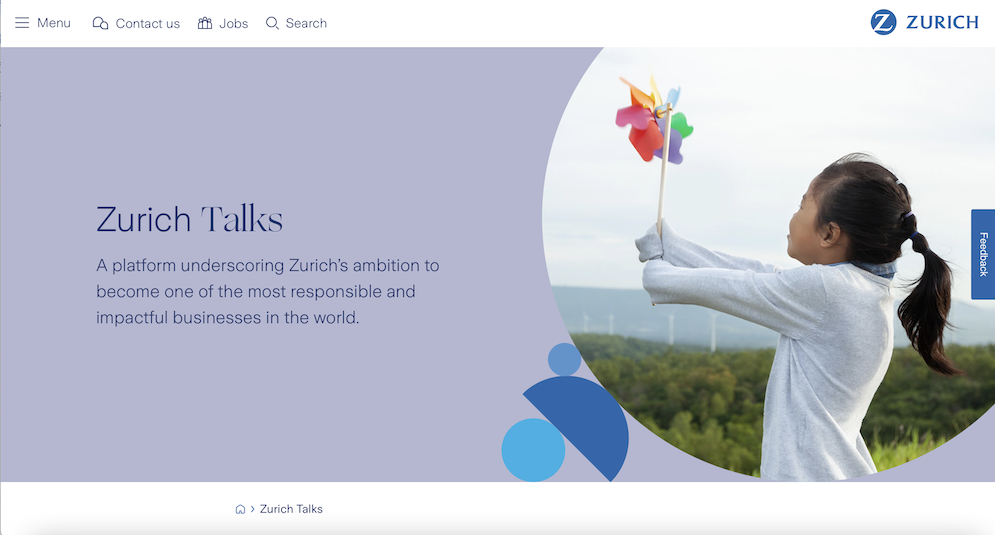The Case for the Corporate Website


Zurich houses a high-profile campaign on their corporate website
The “corporate website” has been around for so long that it’s easy to forget how powerful a tool it can be for delivering on an organisation’s communication strategy, and its business goals.
Investment in corporate digital communications more widely (website, social media, country websites, etc) goes up and down in cycles, and we are in one of those eras when senior decision-makers zero in on value for money, and ask questions such as, “Do we even need a corporate website at all?”.
Here is what we say to clients when they are asked to sell the benefits of the corporate website to those holding the purse strings.
Turning stakeholders into “net promoters”
A company’s reputation comes down to successfully managing relationships – with customers, employees, investors, suppliers, journalists, communities in which it operates, the list goes on. The health of these relationships is a CEO and board-level responsibility, with the communications function tasked with refining the “message” for these audiences.
When it comes to corporate messages underpinning reputation – “we are a sound investment”, “we are innovative”, “you can learn from our experts”, “we are good global citizens” – the global web presence plays a core role in all of them.
The corporate website is the one place where all of your stakeholders convene, and what you say to them has a measurable impact on “net promoter score” (NPS), a key reputation metric. We have seen the impact that a strong web presence can have in turning around the perceptions of key stakeholders in a way that resonates in the executive suite.
Multi-faceted crisis communications tool
We have long said that a corporate crisis is the gateway to understanding how important the biggest owned media channel (the website) can be to a company’s survival. Look at the history of many of the leading companies in the Bowen Craggs Index – it was a crisis that made the penny drop about maintaining a strong global web presence.
This is still true, but we’ve seen two new factors emerge.
First, during Covid, the corporate website became the go-to channel for public service information from the biggest companies in the world about how they were managing the pandemic. It’s not nice to think about, but is Covid likely to be the last of these global crises? Probably not.
Second, companies that were already monitoring corporate website visitor sentiment when a crisis hit have found that they can track in real time how stakeholders were responding, or not, to messages and refine accordingly.
Editorial engine in the age of AI
If you drive people to the web presence with great editorial, from thought leadership to articles about your people, they might just stay to get to know you and hear your point of view. Zurich and Verizon have both housed high-profile campaigns on their corporate websites, rather than set up standalone sites.
Keeping editorial in one place will be vital as ChatGPT and its rivals and successors scrape the internet for information about your company. You want these tools pulling from a single, trusted source. My colleague Andrew Rigby has further pointed out how good SEO techniques also make sense as “GEO” principles in this new world, and the foundation is trustworthy content on a well-constructed website.
Time-saving tool for specialist stakeholders
The same corporate stakeholders that companies are trying to influence with messages also visit corporate websites to carry out tasks. The company has an interest in serving these stakeholders as efficiently as possible: helping them find a job, see financial results, contact a press officer. It’s hard to capture “time saved” in the data but these benefits can be captured qualitatively – from free text responses in surveys or conversations with your stakeholders.
Culture communications for recruitment and retention
For some companies and some CEOs, culture and employee retention are amongst the handful of top priorities for the whole business. In these cases, the corporate website is an invaluable “mixternal” channel, where with a transparent approach, you can communicate with employees and jobseekers at the same time, using one voice and integrating social media links and content as appropriate to provide a holistic view of the corporate culture.
B2B bread and butter
Relatively few companies market and sell via the main corporate web presence, but when they do, it can be the ticket for big ongoing investments. That time and attention often carries over to the less salesy parts of the global web estate, if any kind of visual or usability divide emerges between the product side and the communications side.
Show your excellence in all things, including communications
High-performing companies want to be the best at everything – serving customers, of course, being a great place to work. The corporate website is the shop window where you show that your company excels at stakeholder relationships, transparency and corporate citizenship. Your company wants to excel against competitors in every aspect and this should apply to corporate digital communications too.
Get in touch for more information about Bowen Craggs’ website evaluation, visitor research, consultancy and peer network services for corporate digital communicators.